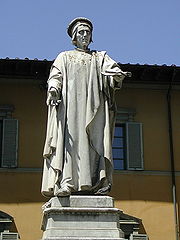
Francesco di Marco Datini
Encyclopedia

Prato
Prato is a city and comune in Tuscany, Italy, the capital of the Province of Prato. The city is situated at the foot of Monte Retaia , the last peak in the Calvana chain. The lowest altitude in the comune is 32 m, near the Cascine di Tavola, and the highest is the peak of Monte Cantagrillo...
.
Biography
He was the only child of Marco di Datino and Monna Vermigilia, who both died as a result of the Black DeathBlack Death
The Black Death was one of the most devastating pandemics in human history, peaking in Europe between 1348 and 1350. Of several competing theories, the dominant explanation for the Black Death is the plague theory, which attributes the outbreak to the bacterium Yersinia pestis. Thought to have...
in 1348.
After his parents death, he was raised by a woman whom he called his "substitute mother." Their relationship seems to have been a positive one. We see a letter from her signed "your mother in love."
He became an apprentice of a merchant in Florence and when he was fifteen, he joined a group of merchants who were going to Avignon
Avignon
Avignon is a French commune in southeastern France in the départment of the Vaucluse bordered by the left bank of the Rhône river. Of the 94,787 inhabitants of the city on 1 January 2010, 12 000 live in the ancient town centre surrounded by its medieval ramparts.Often referred to as the...
, the city where the Popes had moved at the time. His first business was the arms trade, which was quite profitable in Avignon during the Hundred Years' War
Hundred Years' War
The Hundred Years' War was a series of separate wars waged from 1337 to 1453 by the House of Valois and the House of Plantagenet, also known as the House of Anjou, for the French throne, which had become vacant upon the extinction of the senior Capetian line of French kings...
. He eventually became a supplier of luxury goods and art for the wealthy cardinals residing there. The works of art these figures bought were some of the first consumed for private, non religious use. Before this time, the church had been the primary patron of the arts. Later on, the papacy and other pious individuals commissioned religious artwork, creating a use for Francesco's merchant skills. He was not interested in the product itself, but whether it was good quality or not, so that it might please his buyers. This individual buying of artwork is a trend that we see going into the renaissance.
When Datini was more than forty years old he returned to Prato briefly and married Margherita, who was 25 years his junior. The correspondence through letter provides us with exchanged letters weekly while Datini was away on business, which provides most of the information available today on his life. In the year 1400 (around the time of 17 June), the two fled from Prato to Bologna in fear of the Black Death, along with Datini's illegitimate daughter. He returned to die a natural death in 1410.
He is buried in the church of San Francesco in Prato
Prato
Prato is a city and comune in Tuscany, Italy, the capital of the Province of Prato. The city is situated at the foot of Monte Retaia , the last peak in the Calvana chain. The lowest altitude in the comune is 32 m, near the Cascine di Tavola, and the highest is the peak of Monte Cantagrillo...
. His tomb marble slab was designed by Niccolò di Pietro Gerini
Niccolò di Pietro Gerini
Niccolò di Pietro Gerini was an Italian painter of the late Gothic period, active mainly in his native Florence. Niccolo di Pietro Gerini's works can be found in major art galleries in Rome, the Vatican, Florence, London, Milan, New York, Los Angeles, Amsterdam, Berlin, Paris, St Petersburg,...
.
See also
- Madonna del CeppoMadonna del CeppoThe Madonna del Ceppo is a painting by the Italian Renaissance painter Filippo Lippi, commissioned to him between 1452 and 1453. It is housed in the Civic Museum of Prato, Italy...
, a painting by Filippo LippiFilippo LippiFra' Filippo Lippi , also called Lippo Lippi, was an Italian painter of the Italian Quattrocento .-Biography and works:...
depicting him - History of ChiantiHistory of ChiantiThe history of Chianti dates back to at least the 13th century with the earliest incarnations of Chianti as a white wine. Today this Tuscan wine is one of Italy's most well known and recognizable wines...

